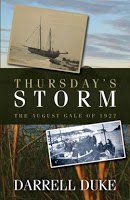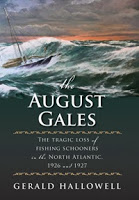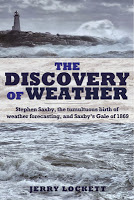I recently completed Jerry Lockett’s The Discovery of Weather: Stephen Saxby, the tumultuous birth of weather forecasting, and Saxby’s gale of 1869 (M). It is a very entertaining and informative book. I also gained a greater respect for the power of nature and the resiliency of our forebearers.
The first half of the book traces the history of weather forecasting, all the way from the early astrology based theories, to the early almanacs, to the slow development of meteorology as an accepted science. This history is surprising rich, with many brilliant, stubborn and colourful personalities competing to be first to unravel the secrets of the weather. The quest wasn’t just for personal glory though, as the amount of lives lost to storms in 17th century was absolutely staggering and was a great incentive to develop some sort of forecasting system.
The second part of the book traces the actual impact of the storm, i.e. Saxby’s Gale, on the Maritimes. If you are the type of person who can enjoy watching the Weather Network at all, you’ll absolutely love this part. The stories of the devastating damage and heroic survival are both frightening and awe inspiring.
In a simlar vien, here are two new books about the August Gale of 1927, another infamous storm that devastated many parts of Atlantic Canada.
Thursday’s Storm: the August gale of 1927 (M)
by Darrell Duke
 “When the crew of the fishing schooner Annie Healy left their home port of Fox Harbour, Placentia Bay, on Wednesday, August 17, 1927, no one could have imagined what fate held in store for them. Times were hard in Newfoundland that year. On shore, wives of the crew were often worked to exhaustion, even more so while their men were at sea. Most had lost parents, siblings, or children to tuberculosis. Each family had at least one tragic story. But when a hurricane struck Placentia Bay on August 25 of that year, a tragedy unlike any they had lived through would unite these people in ways untold. Now, eighty-six years later, the full story of the ill-fated vessel and her crew is told for the first time. The closeness of the crew and their families, and how they worked together to ensure their little community survived, is relived through the memories of children of the crew, stories passed down from their mothers, and reports from the last men to see the schooner afloat”–Provided by publisher.
“When the crew of the fishing schooner Annie Healy left their home port of Fox Harbour, Placentia Bay, on Wednesday, August 17, 1927, no one could have imagined what fate held in store for them. Times were hard in Newfoundland that year. On shore, wives of the crew were often worked to exhaustion, even more so while their men were at sea. Most had lost parents, siblings, or children to tuberculosis. Each family had at least one tragic story. But when a hurricane struck Placentia Bay on August 25 of that year, a tragedy unlike any they had lived through would unite these people in ways untold. Now, eighty-six years later, the full story of the ill-fated vessel and her crew is told for the first time. The closeness of the crew and their families, and how they worked together to ensure their little community survived, is relived through the memories of children of the crew, stories passed down from their mothers, and reports from the last men to see the schooner afloat”–Provided by publisher.
The August Gales: the tragic loss of fishing schooners in the North Atlantic, 1926 and 1927 (M)
by Gerald Hallowell
 Three different fishing communities, three different countries, but in their pursuit of fish on the banks they would have much in common, including the terrors of the North Atlantic storms. The August Gales is a richly detailed history of the banks fishery, the perils of the North Atlantic, and more specifically, the three powerful, and ultimately deadly, August storms that devastated not only an industry, but entire communities. The great gale of 1873, which struck near the eastern mainland of Nova Scotia, was only a prelude to the gales of 1926 and 1927, which brought unthinkable grief to the towns of Lunenburg and Gloucester as well as the island of Newfoundland. (On one fateful day, a woman in the village of Blue Rocks, near Lunenburg, lost her husband, two of his brothers, and three of her own brothers.) Impeccably researched and with over 40 black and white images, The August Gales is a fascinating and at times moving account of the schooners that made their living, and met their end, in the famed North Atlantic gales.
Three different fishing communities, three different countries, but in their pursuit of fish on the banks they would have much in common, including the terrors of the North Atlantic storms. The August Gales is a richly detailed history of the banks fishery, the perils of the North Atlantic, and more specifically, the three powerful, and ultimately deadly, August storms that devastated not only an industry, but entire communities. The great gale of 1873, which struck near the eastern mainland of Nova Scotia, was only a prelude to the gales of 1926 and 1927, which brought unthinkable grief to the towns of Lunenburg and Gloucester as well as the island of Newfoundland. (On one fateful day, a woman in the village of Blue Rocks, near Lunenburg, lost her husband, two of his brothers, and three of her own brothers.) Impeccably researched and with over 40 black and white images, The August Gales is a fascinating and at times moving account of the schooners that made their living, and met their end, in the famed North Atlantic gales.






